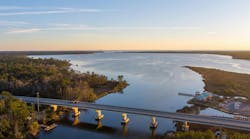Heather Buck, CPWSQ, CMS4S, says most municipalities are complying with stormwater regulations, but not sufficiently documenting it. A resource planner for Christopher B. Burke Engineering in Indianapolis, IN, Buck helps municipalities with recordkeeping, tracking, and documentation in an “easy and efficient way so they can fit records documentation into their existing process.”
Her company specializes in planning, design, and construction management of municipal and private infrastructure projects. Buck is engaged in “training the trainer” activities, traveling throughout Indiana to help train municipal staff and their department heads in preparing for upcoming regulations, which they in turn teach to their own staff. Audit preparation is another weak area Buck observes among municipalities. The state’s MS4 representative visits MS4-permitted entities to ensure compliance in areas such as good housekeeping and pollution prevention. The representative conducts audits by meeting with staff, checking paperwork, and doing facility walk-throughs.
Before the representative’s arrival, Buck helps offer a “third-party eye” to help ensure they’re on track. “Most of them are doing some really good things,” says Buck. “It’s just a tweaking of process or activities to enhance what they’re doing to show they are visibly compliant.” Her work sometimes takes her beyond Indiana to do presentations for the International Erosion Control Association or StormCon to share common effective experiences of different MS4 entities.
What She Does Day to Day
Buck works with county and city MS4 clients on permit compliance, ensuring their documentation is update and stormwater regulation preparations are audited. She also conducts facility inspections.
What Led Her Into This Line of Work
Buck’s college major in pharmacy didn’t “click” for her, but she stuck with biology as she loved the field classes. The curriculum required Occupational Safety and Health Administration education in regulations, safety, and compliance. She earned a B.S. in environmental studies and biology from Ohio Northern University and an M.S. in environmental safety and health management from the University of Findlay. Her first job: Mercer County Ohio Soil & Water Conservation District watershed coordinator, where she worked mostly with agricultural communities and some urban residents. She educated schoolchildren on water quality, sediment, and the process and ramifications of erosion, sedimentation, and pollution.
After moving to Indianapolis, Buck began working for Christopher B. Burke Engineering in watershed work, then in water quality and stormwater compliance. Buck is branching out into wetland delineation to help stormwater clients. She also does FEMA-required multi-hazard mitigation plans for flood, tornado, earthquake, and drought events. Her field work gives her “lots of interaction with clients, staff, and the public. That’s what I prefer,” she says.
What She Likes Best About Her Work
Buck says she loves it when a plan comes together and is implemented. Her interaction with different people whose efforts are on various levels range from those who are “sort of” keeping compliance and are of the mindset that it’s good enough to clients who “really want to push and get innovative things done,” says Buck. “We’ve got others who are tweaking it and asking if it can work if they change it a certain way.”
Buck also enjoys interacting with municipal staff and members of the public to explain the consequences of certain practices, such as why one should not pour oil down a drain. “It’s not just ‘It’s the government telling me I can’t do this,'” she says. “It’s working it back and saying if you like to fish, canoe, or camp, this is how that one interaction can impact you—and not just you, but everyone around you.”
Her Greatest Challenge
Buck’s greatest satisfaction also provides her greatest challenges. “The challenge is taking the spectrum of clients and innovations and getting some folks to take a baby step out of their comfort zone and running with the ones who really want to push that envelope to see how far they can go and what they can do,” she says. “It’s showing them here’s how other states in the same Environmental Protection Agency region and even in different regions are approaching things, and just keeping myself up on how others are doing things. It’s definitely a moving target, and it’s always something different.”


